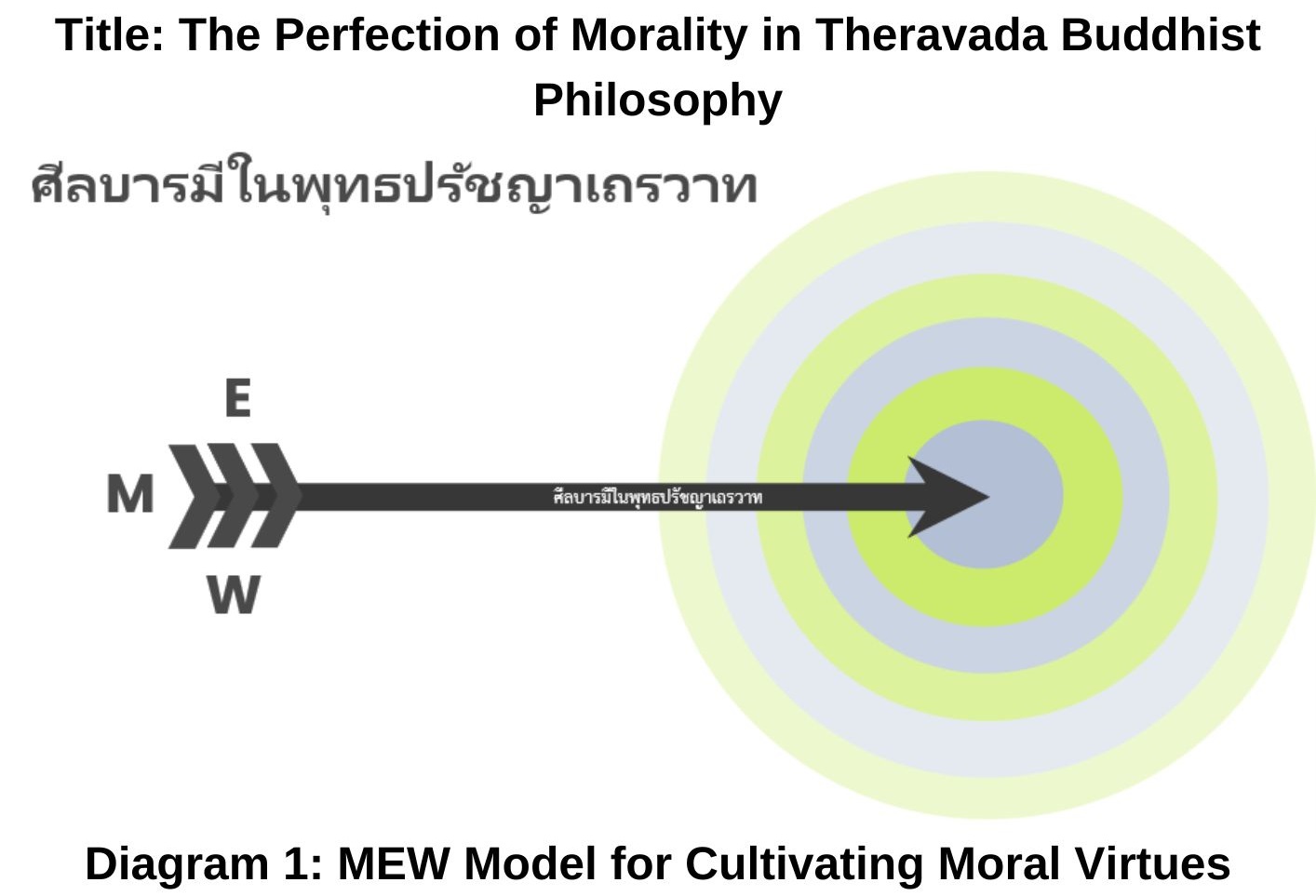The Perfection of Morality in Theravada Buddhist Philosophy
Keywords:
Morality, Perfection, Perfection, Perfection of Morality, Theravada Buddhist PhilosophyAbstract
This article aims to analytically study The Perfection of Morality in Theravada Buddhist Philosophy. The findings reveal that The Perfection of Morality in Theravada Buddhist Philosophy refers to the "virtue of morality" or "perfection of morality," which is one of the Ten Perfections essential for mental development and the attainment of the highest spiritual goal. Morality in Theravada Buddhist Philosophy is established based on the rationale of natural law, aligning with reality. It is a principle of purity and serves as a model of goodness. A new framework for understanding The Perfection of Morality in Theravada Buddhist Philosophy is introduced, called the “MEW Model for Practicing The Perfection of Morality,” which consists of : M = Mindfulness : This involves having awareness and mental focus, a firm determination to practice The Perfection of Morality, and achieving mental tranquility. It signifies the internal calm achieved by overcoming the five sensual desires (kama-raga) and the steadfastness that comes from patience (khanti-barami). This is akin to aiming an arrow precisely at the aim (The Perfection of Morality). E = Effort : This represents perseverance, comparable to the speed of an arrow moving towards the target without slackening. It involves having the necessary momentum to reach the set goal. W = Wisdom : This refers to the wisdom or understanding that guides the correct practice of moral precepts without deviation. It is like having the skill and insight to clearly understand where the target is, ensuring the arrow (The Perfection of Morality) hits the intended mark.
References
นวลวรรณ พูนวสุพลฉัตร. (2556). การศึกษาพระราชจริยาวัตรของพระบาทสมเด็จพระเจ้าอยู่หัวอันเนื่อง ด้วยการปฏิบัติธรรมในพระพุทธศาสนา. วิทยานิพนธ์พุทธศาสตรดุษฎีบัณฑิต. บัณฑิตวิทยาลัย : มหาวิทยาลัยมหาจุฬาลงกรณราชวิทยาลัย.
พระกวีวงศ์ (อิ่ม สารโท). (2556). ธรรมสมังคีของทศบารมีเป็นปัจจัยเกื้อหนุนในการตรัสรู้และการบำเพ็ญพุทธกิจของพระพุทธเจ้า. วิทยานิพนธ์พุทธศาสตรดุษฎีบัณฑิต. บัณฑิตวิทยาลัย : มหาวิทยาลัยมหาจุฬาลงกรณราชวิทยาลัย.
พระชนาเมธ เตชธโร (คำมุงคุณ) และ เสฐียร ทั่งทองมะดัน. (2565). ศีลในวิสุทธิมรรคในฐานะเป็นภาพสะท้อนวิถีชีวิตของพระสงฆ์ในพระพุทธศาสนา. วารสารวิชาการ มจร บุรีรัมย์, 7(1), 335-349.
พระธรรมธีรราชมหามุนี (โชดก ญาณสิทธิ). (2550). คําบรรยายวิปัสสนากรรมฐาน. กรุงเทพฯ : บริษัท ประยูรวงศ์พริ้นติ้ง จํากัด.
พระปลัดกิตติ ยุตฺติธโร. (2562). การประยุกต์ใช้ศีล 5 เพื่อพัฒนาคุณภาพชีวิตของบุคลากร วิทยาลัยสงฆ์บุรีรัมย์. วารสารธรรมวิชญ์, 2(2), 293-305.
พระพรหมคุณาภรณ์ (ป.อ. ปยุตฺโต). (2548). พจนานุกรมพุทธศาสตร์ฉบับประมวลธรรม. พิมพ์ครั้งที่ 13. กรุงเทพฯ : บริษัท เอส.อาร์.พริ้นติ้ง แมส โปรดักส์ จำกัด.
_________. (2551). พจนานุกรมพุทธศาสน์ ฉบับประมวลศัพท์. พิมพ์ครั้งที่ 11. กรุงเทพฯ : บริษัท เอส. อาร์ พริ้นติ้ง แมส โปรดักส์ จำกัด.
พระพุทธโฆสเถระ. (2556). คัมภีร์วิสุทธิมรรค. แปลและเรียบเรียงโดย สมเด็จพระพุฒาจารย์ (อาจ อาสภมหาเถร). พิมพ์ครั้งที่ 11. กรุงเทพฯ : โรงพิมพ์ บริษัท ธนาเพรส จำกัด.
พระมหาจู่ล้อม ชูเลื่อน. (2546). ความกล้าหาญทางจริยธรรมในการบำเพ็ญบารมีของพระโพธิสัตว์ในทศชาติชาดก. วิทยานิพนธ์ศิลปศาสตรมหำบัณฑิต. บัณฑิตวิทยาลัย : มหาวิทยาลัยมหิดล.
พระมหาพงศ์ศิริ ปญฺญาวชิโร. (2564). วิเคราะห์ทานบารมีในคัมภีร์อรรถกถาชาดก. วารสารสหวิทยาการมนุษยศาสตร์และสังคมศาสตร์, 4(1), 63-73.
พระสุรเชษฐ์ อิทฺธิเตโช (ไชยรา) และคณะ. (2564). การประยุกต์ใช้หลักศีล 5 ในการพัฒนาคุณภาพชีวิต ประจำวันของประชาชน บ้านส้มป่อยค่ายเมืองแสน ตำบลนาด่าน อำเภอสุวรรณคูหา จังหวัดหนองบัวลำภู. วารสารปัญญาปณิธาน, 6(1), 215-228.
พุทธทาส อินทปญฺโญ. (2520). อริยศีลธรรม. กรุงเทพฯ : หจก. การพิมพ์พระนคร.
มหาจุฬาลงกรณราชวิทยาลัย. (2539). พระไตรปิฎกภาษาไทย ฉบับมหาจุฬาลงกรณราชวิทยาลัย. กรุงเทพฯ : โรงพิมพ์มหาจุฬาลงกรณราชวิทยาลัย.
วศิน อินทสระ. (2557). สาระสําคัญแห่งวิสุทธิมรรค. พิมพ์ครั้งที่ 5. กรุงเทพฯ : โรงพิมพ์เม็ดทราย.
สมเด็จพระเทพรัตนราชสุดาฯ สยามบรมราชกุมารี. (2524). “ทศบารมีในพุทธศาสนาเถรวาท”. วิทยานิพนธ์อักษรศาสตรมหาบัณฑิต. บัณฑิตวิทยาลัย : จุฬาลงกรณ์มหาวิทยาลัย.
สมเด็จพระมหาสมณเจ้า กรมพระยาวิชรญาณวโรรส. (2499). ธรรมวิภาค ปริเฉทที่ 2. กรุงเทพฯ : โรงพิมพ์มหามกุฎราชวิทยาลัย.
_________. (2514). บาลีไวยากรณ์ วจีวิภาคภาคที่ 2 สมาสและตัทธิต. กรุงเทพฯ : มหามกุฎราชวิทยาลัย.
สมโภชน์ ยิ่งสังข์. (2552). การศึกษาเชิงวิเคราะห์ศีลบารมีในภูริทัตชาดก. วิทยานิพนธ์พุทธศาสตรมหาบัณฑิต. บัณฑิตวิทยาลัย : มหาวิทยาลัยมหาจุฬาลงกรณราชวิทยาลัย.
Maha Chakri Sirindhorn HRH Princess Maha Chakri Sirindhorn. (2000). The Ten Perfections in Theravada Buddhism. (4th ed.). Nakorn Pathom : Mahamakut Buddhist University Printing House.

Downloads
Published
How to Cite
Issue
Section
License
Copyright (c) 2024 Institute of Sufficiency Journal

This work is licensed under a Creative Commons Attribution-NonCommercial-NoDerivatives 4.0 International License.


